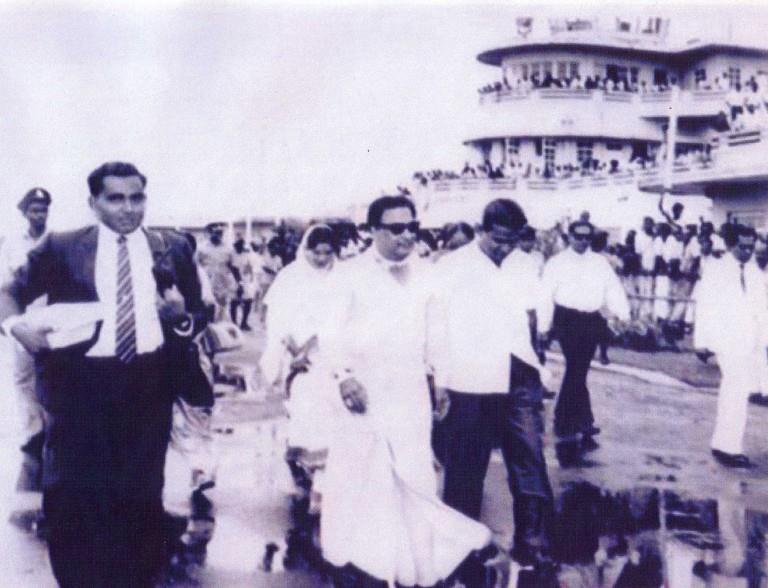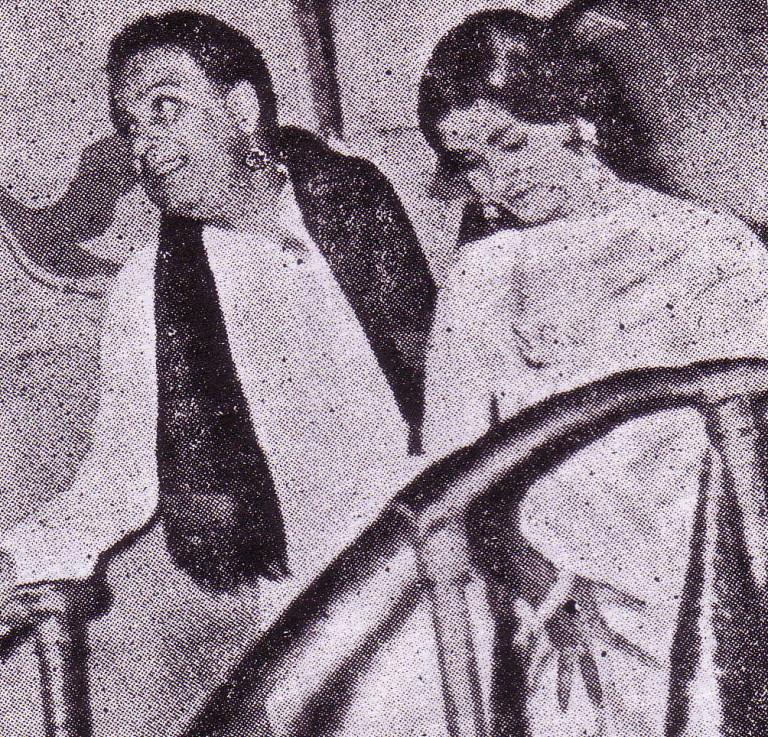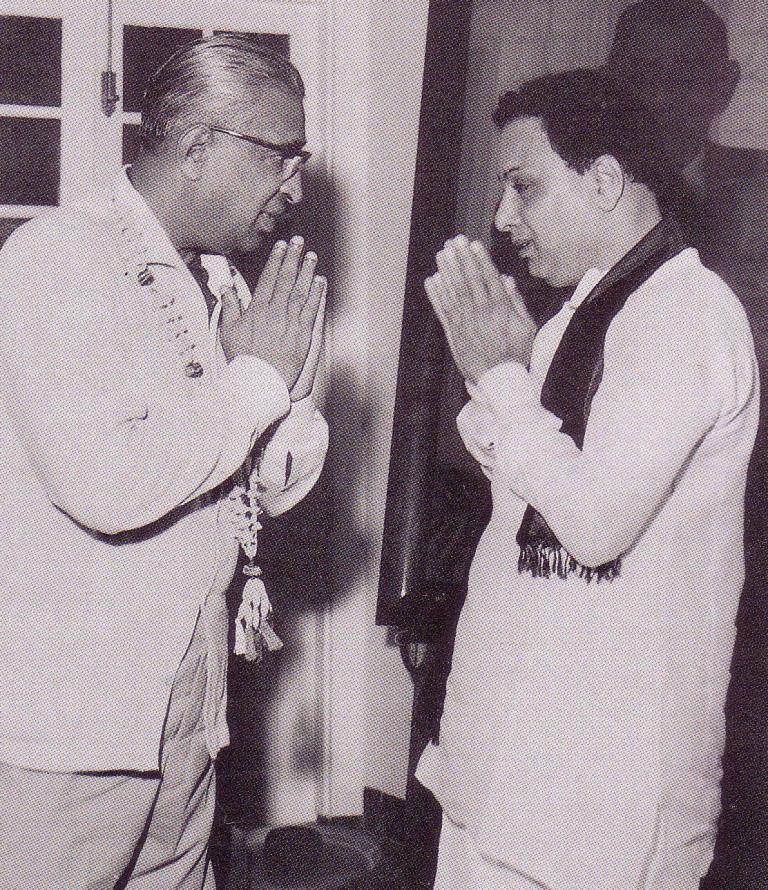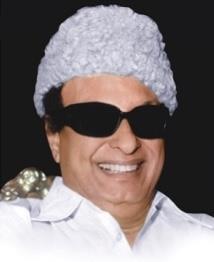
Kandy-Born MGR Was The Uncrowned King Of Both Tamil Cinema And Tamil Nadu
December 24: Maruthur Gopalan Ramachandran known popularly as MGR ruled Tamil movidom for three decades until becoming Chief Minister of India's Tamil Nadu State in 1977. MGR served as chief minister (CM) for ten years until his demise in 1987. His 36th death anniversary will be commemorated this week on December 24.
MG Ramachandran entered active politics in the fifties of the last century. He was elected to the state legislature in the sixties and became CM in the seventies. When he died after 10 years as Chief Minister on 24 December 1987, MGR was 70 years of age
ADVERTISEMENTMGR –born in Sri Lanka - was a Malayalee hailing from Kerala. He grew up in Tamil Nadu and was active in politics for decades before forming a party and becoming CM.
M.G. Ramachandran's or MGR's life was a rags to riches tale!
Dravidian
Since 1967 the South Indian State of Tamil Nadu has been ruled by political parties adhering to what is termed as Dravidian ideology. 'Dravidianism' in essence espouses economic development, social justice, equality, the elimination of caste discrimination, women emancipation, secularism, rationalism, self-respect, greater cooperation among South Indian states, Opposition to Hindi imposition and a Tamil national consciousness.
The 'Dravidian' political ideology has been ruling the roost in Tamil Nadu for the past 56 years. Either the Dravida Munnetra Kazhagham (DMK) or its alternative the All India Anna-Dravida Munnetra Kazhagham (AIADMK) have been enjoying power in the State. Currently the DMK is ruling the state
In spite of this“Dravidian” heritage of rationalism and self-respect, it is Tamil Nadu that has allowed film stars to exercise political hegemony like no other. In 1977, M.G. Ramachandran became the first film star to take up chief ministership of an Indian state. He ruled from 1977 to 1987 being thrice elected as chief minister of Tamil Nadu. After his death MGR was succeeded briefly by his wife Janaki Ramachandran, who was herself a former film heroine. Then came, Jayalalithaa Jayaram, MGR's 'leading' lady with whom he had starred in 28 films. She ruled for a total of 15 years. Jayalalithaa was elected as chief minister in 1991, 2001, 2011 and 2016. As a Tamil wag put it,“MGR is the only actor-chief minister, who ensured that his actor wife as well as actor paramour succeed him as CM.”

MGR arriving at Ratmalana airport, Colombo
Sri Lankan Connection
Interestingly, MGR had a Sri Lankan connection being born in Hantane, Kandy. His father was at that time teaching in an estate school in Kandy. MGR, the youngest child, was born at home in Hantane on Jnuary 17, 1917. He grew up in Kandy till he was two. In 1919 the family returned to India.
MGR's father Gopalan Menon was a judicial officer who served in places like Trichur and Ernakulam in what is today India's Kerala State. MGR's mother Sathyabhama was a not-so-well-educated housewife. There were five children in all. Four were born in India. They were two boys named Chakrapani and Balakrishnan and two girls named Kamalaatchi and Subathra. The youngest born in Sri Lanka was given the name Ramachander at birth. M.G. Ramachander later altered his name to Ramachandran. Three of the five children died in their infancy. Only the eldest Chakrapani born in 1911 and the youngest Ramachander survived.
Meanwhile, the father fell into trouble over an ethical issue. He was interdicted pending a disciplinary inquiry. A chagrined Gopalan Menon resigned and sought fresh employment elsewhere. Sri Lanka during the period of British rule was a powerful magnet for many unemployed or underemployed people of South India. Thus Gopalan or Gopalan Menon (Menon is a caste-denoting suffix) obtained a teaching job in the Island and moved to Kandy where Ramachander was born. However Gopalan fell ill and in 1919 returned to India with his family. They took up residence in a place called Othappaalam where Gopalan started tutoring children from rich families.
Tragedy struck in 1920 as Gopalan passed away due to illness when young MGR was only three and Chakrapani nine. Their mother Sathyabhama then relocated to Kumbakonam, in present day Tamil Nadu, where her brother Narayanan's family was residing. Chakrapani continued his studies at the Aanaiaddy School in Kumbakonam. A few years later Ramachander also started going to the same school.
Sathyabhama called Sathya struggled to bring up her two sons. She worked as a domestic servant doing cleaning in Brahmin homes. After a while brother Narayanan suggested that Chakrapani should give up school and find work because of the family's precarious financial state. Narayanan himself was attached to the drama troupe 'Madurai Original Boys Company'. The troupe specialised in staging plays with young boys as actors. Uncle Narayanan found a place for the nephew at the drama company as an actor. A few years later Ramachander also followed his elder brother's footsteps and joined the Boys Company. Both brothers toured many places as drama actors.
Sathi Leelavathy
Meanwhile, the cinema industry began taking root in India. The silent movies gave way to talkies and filmmaking became a craze. Many film companies hired stage actors to act on screen also. Young Ramachander got his first chance in films when the film 'Sathi Leelavathy' was made in 1936.
MGR's career as a film actor proceeded in fits and starts. Though he had the necessary looks, physique and martial skills required by an actor, MGR lacked a good singing voice. In those days the main actors had to sing in their own voices on screen. A Tamil film of yore had song sequences numbering double digits. The inability to sing deprived MGR of opportunities to act in lead or meaty roles. He had to be content with minor roles. MGR acted in only 20 films during the 1936 to 1947 years. His name was displayed as M.G. Ramachander in the titles then.
The film song sphere in Tamil moviedom got a fillip in the forties of the last century. Instead of compelling actors to sing in their own voices, filmmakers introduced the art or craft of playback singing. The songs would be sung by reputed singers and recorded. The actors on screen would lip synch accordingly. Thereafter the sound track and film track would be synchronised accordingly via re-recording. This innovation enabled actors lacking singing talent to get good or lead roles in films.
The novelty of playback singing was like manna from heaven to MGR. A noted singer, M.M. Maariyappah, began to voice for MGR in films. In later years singers like T.M. Soundararajan, Seergali Govindarajan, A.M. Rajah, C. S. Jayaraman, S.P. Balasubramaniam and K.J. Yesuthas voiced for MGR. T.M. Soundarajan is regarded as the best playback singing voice for MGR.
M.G. Ramachandran was picked by Jupiter films to play the hero in the film 'Rajakumari' (Princess). 'Rajakumari' was a roaring success commercially. MGR now began getting more lead roles. In most films he played an action hero. Soon he became a popular actor whose films were box office hits. The magic initials“MGR” began garnering an incredible number of fans.
Even as MGR was tasting triumph as an actor, tragedy struck. His mother Sathya passed away in 1950. Thereafter MGR began to treat his mother as a divine being and worshipped her portrait daily. He also re-named the Neptune studio he acquired as Sathya Studios and floated a movie production company called Sathya Movies. His residential estate in Ramaavaram was also called Sathya Thottam.

MGR and Sarojadevi arriving at Palali Jaffna airport
V.N. Janaki
The death of his mother was not the only blow MGR suffered. He lost his first wife Paarkavi a.k.a. Thangamani in 1942 after two years of married life. His second wife Sathaananthavathi whom he married in 1943 was afflicted with tuberculosis and was bedridden for many years. She died in 1962. MGR's third wife was V.N. Janaki an actress herself. Cupid's arrows pierced their hearts when they first acted together in the film 'Marutha Naattu Ilavarasi' (Princess of Marutha Country).
Though MGR and Janaki fell in love they could not get married formally as both were married to other persons. MGR was married to Sathaananthavathi and Janaki to another artiste named Ganapathy Bhatt. Janaki separated from Bhatt and filed for divorce. She obtained a divorce after protracted legal proceedings. She began living together with MGR from 1959 but could not marry him because his wife Sathaanandavathy was alive. It was only after her death in 1962 that Janaki and MGR got married legally in 1963. Janaki survived MGR and passed away in 1996.
MGR acted in 116 films during the period from 1947 to 1978. He gave up acting in 1977 after he became Tamil Nadu Chief Minister. His last film 'Maduraiyai Meetta Sundarapaandiyan' (Madurai Liberator Sundarapaandiyan) was released in 1978. Twelve of MGR's films were silver jubilee hits running for over 25 weeks each. Another 68 films ran for more than 100 at theatres during their first screenings. Even the MGR films that did not initially run for 100 days turned out to be money-spinners in the long run as each re-release brought large audiences to theatres.
MGR had a formula of his own in the films he acted in. The story had to be sentimental with displays of mother-son love or brother-sister affection. Despite ups and downs and twists and turns, the good guy had to triumph in the end. Needless to say MGR was always the good guy except for a few in the early stages of his career. The films had to have a positive message imparting a lesson to the people. The hero was regularly portrayed as a paragon of virtue who fights for justice on the side of the oppressed. The hero sings philosophical songs.
Jayalalithaa Jayaram
Besides these features, a typical MGR film always had thrilling fight scenes and titillating love song sequences. MGR got the finest villain actors to play opposite him. Likewise MGR always had the loveliest actresses as his scintillating heroines on screen. Among the actresses with whom MGR paired in the most number of films was Jayalalithaa Jayaram as leading lady. It was well-known that MGR was infatuated with the alluring actress with whom he acted in 28 films. Though unmarried, Jayalalithaa was regarded as the love of MGR's life. There was a time when MGR in a movie called 'Thanipiravi' (Unique Being) played Lord Muruga and Jayalalithaa his consort Valli in a dream sequence. A picture of both together as Murugan and Valli was framed and worshipped by many of his fans.
MGR himself underwent two transformations as his acting career blossomed. Firstly he changed his name from Ramachander to Ramachandran. Nevertheless it was as MGR that he was widely known. Secondly, he joined the ranks of the newly-formed Dravida Munnetra Kazhagham (DMK) led by C.N. Annadurai known as“Anna” or elder brother.
In Tamil Nadu it was the DMK that first attempted to use cinema for political propaganda in the post-independence years. Films scripted by Annadurai were well-received and its political content made great impact. But it was his deputy, Karunanidhi who really hit it big as script-writer. Karunanidhi developed a writing style that was flowery and alliterative and soon became very popular. It was Karunanidhi who enticed MGR into the DMK political fold. Both Annadurai and Karunanidhi became chief ministers in later years.
Even as film stars were being used for political propaganda, the film stars in turn began using politics for their personal advancement. MGR himself commenced constructing and consolidating a personal political base. When he starred in films, the lines he delivered on screen carried hidden political meaning. An example was the constant reference to the morning sun, the DMK symbol. In colour productions, MGR would wear the party colours, black and red. He also sang songs on screen pledging sweeping social reforms that would remove socio-political inequalities.

MGR with Ceylonese Prime Minister Dudley Senanayake in 1965
Screen Persona
Gradually, MGR's screen persona started reflecting the DMK's image. The difference between reality and make-believe blurred, while he continued to pull crowds. As Annadurai once said of MGR,“Sollukku pathu latcham. Mugathukku muppathu latcham.” (One million votes for his speech. Three million for his face).
In his roles, MGR always fought for the underdog against tyranny and injustice. He took special care to project a social message in most songs and took care to act in different roles so that different segments of the population could relate to and identify with him. The movies, titled simply but astutely, in which he played lead roles, include 'Padagotti' (Boatman), 'Meenava Nanban' (Fisherman Friend), 'Thozhilaali' (Worker), 'Vivasayee' (Agriculturist), 'Rickshawkaran' (Rickshawalla) and so on. These occupational groups began treating MGR as one of their own.
A unique feature of the relationship between the movie stars of the Indian south and their fans was the phenomenon of fan clubs. M.G. Ramachandran probably encouraged the proliferation of fan clubs from late 1940s onwards and the clubs ended up as a well-knit federation that counted its membership in the millions. The clubs held annual conventions and also participated in social service projects.
When MGR entered active politics, his fan clubs were in turn politicised and soon became an indispensable component of the DMK propaganda machine. In MGR's case both spheres mutually reinforced each other - film popularity providing political mileage and political positions strengthening film popularity.
The popularity of MGR within the DMK party and Tamil Nadu State caused major convulsions. In a bid to counteract MGR's charisma, the then DMK chief minister Karunanidhi encouraged his son M.K. Muthu to enter movies. The father, while in office as Chief Minister, wrote the story and dialogue for Muthu's first film 'Pillaiyo Pillai' (Oh, What a Son). Muthu fan clubs were set up overnight, with father Karunanidhi's backing.
Party Split in 1972
MGR, realising what was in store, engineered a split within the party in 1972 on the grounds of corruption charges against the incumbent regime. Incidentally, MGR did not have any problems in setting up new party structures -he merely converted his fan clubs into party branches.
MGR formed the Anna-Dravida Munnetra Kazhagham (ADMK) after splitting from the DMK in 1972. He later amended it to All-India Anna Dravida Munnetra Kazhagham (AIADMK). His followers who dubbed him earlier as“Puratchi Nadigar” or 'Revolutionary Actor' now hailed him as“Puratchy Thalaiver” (Revolutionary Leader). MGR incurred much mirth among political pundits when he stated that his party ideology was a blend of“capitalism, socialism and communism”. MGR had the last laugh on his detractors when his party romped home as winners in 1977.
MGR became Chief Minister of Tamil Nadu. MGR was elected Chief Minister again in 1980 and 1985 after his party won at the polls. He was now praised as“Puratchi Mudhalvar” (revolutionary chief minister). MGR died in harness as Chief Minister in 1987. Prime Minister Rajiv Gandhi bestowed upon him posthumously the“Bharat Ratna” which is the highest civilian honour in India.
MGR Legacy
The MGR phenomenon was no doubt unique, and his mystique continues its hold over Tamil psyche even today. Before his death, he had come to personify the aspirations of the common people but as more than just a symbol. As political leader, he was also seen as a vehicle for realising their dreams. So powerful and lasting has been the MGR legacy that, decades after his death, the crowds cheer madly at the mere mention of his name at election meetings in Tamil Nadu.
(D.B.S. Jeyaraj can be reached at [email protected] )

Legal Disclaimer:
MENAFN provides the
information “as is” without warranty of any kind. We do not accept
any responsibility or liability for the accuracy, content, images,
videos, licenses, completeness, legality, or reliability of the information
contained in this article. If you have any complaints or copyright
issues related to this article, kindly contact the provider above.


















Comments
No comment